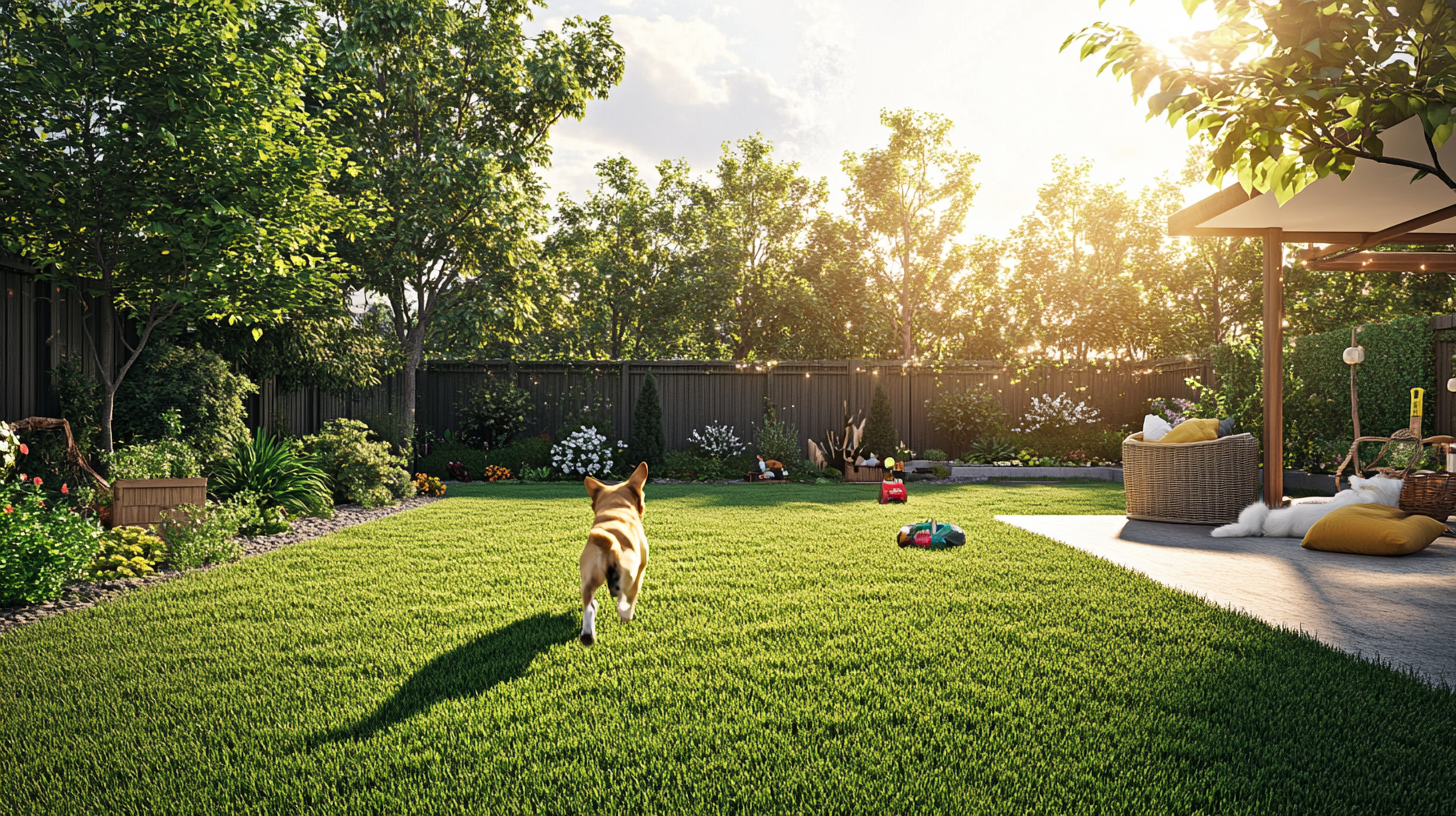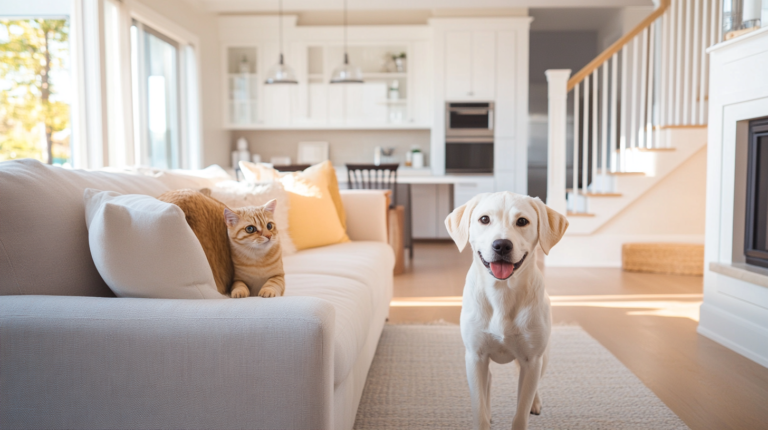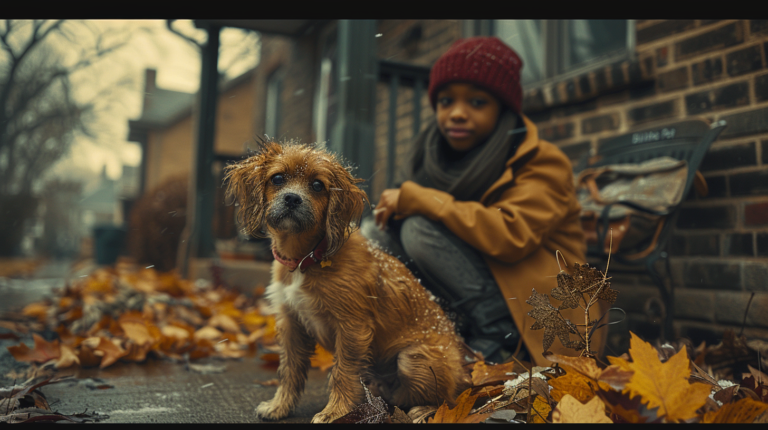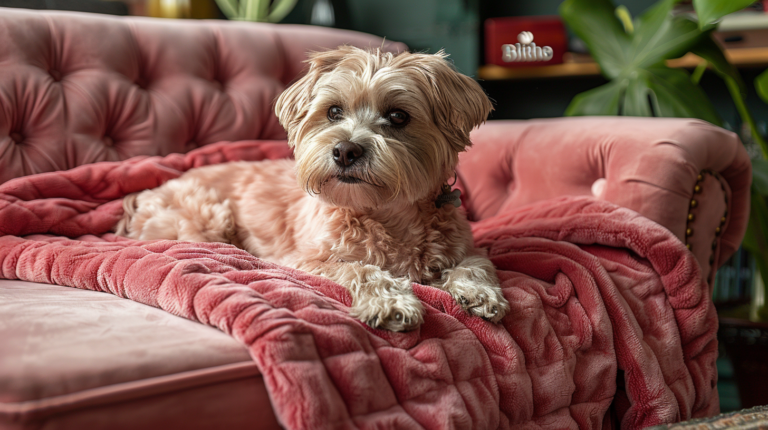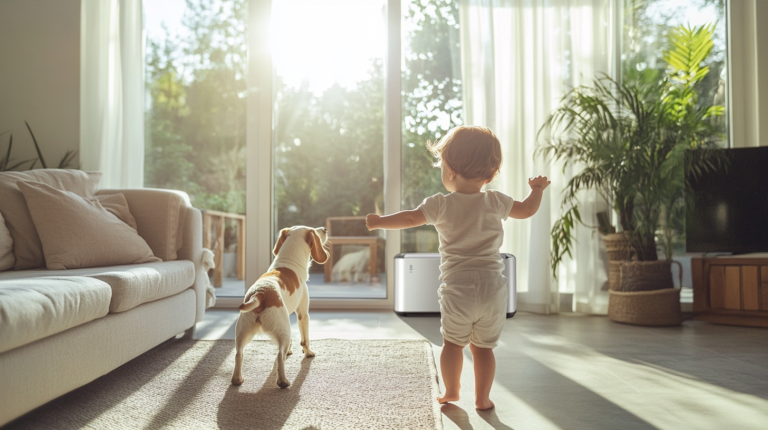Discover 5 brilliant ways to create a safe outdoor space for pets with our comprehensive guide covering secure boundaries, pet-friendly landscaping, weather protection, and more.
Table of Contents
Introduction: Why Your Pet Deserves a Safe Outdoor Space
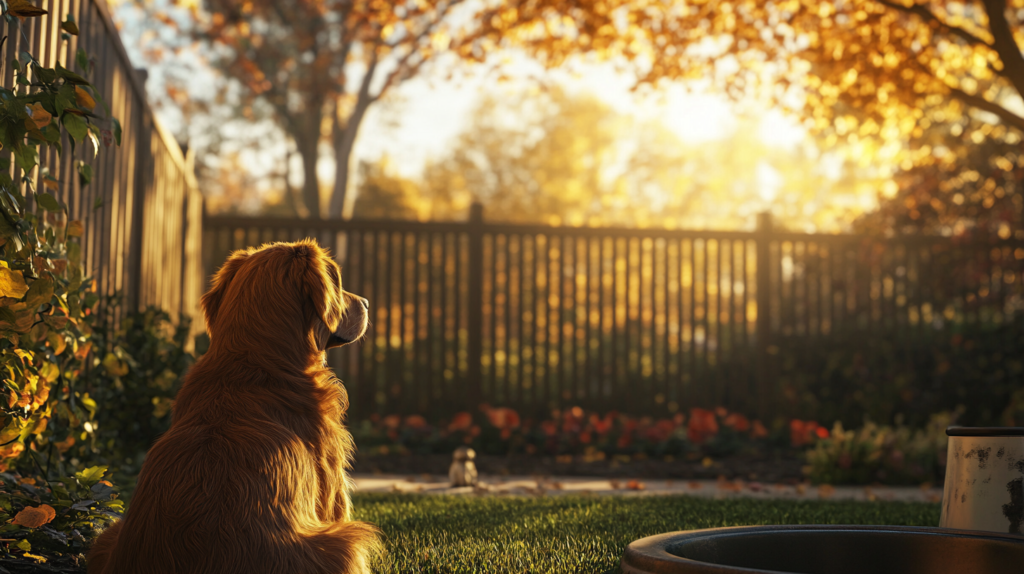
For pet owners, creating a safe outdoor space for pets isn’t just about convenience—it’s about enrichment, health, and happiness. Whether you have a sprawling backyard or a modest balcony, transforming your outdoor area into a pet-friendly haven can significantly improve your furry friend’s quality of life. Pets that have access to secure outdoor environments tend to exhibit fewer behavioral problems, maintain healthier weights, and enjoy better mental stimulation.
According to the American Veterinary Medical Association, regular outdoor time is essential for most pets’ physical and psychological well-being. However, the outdoors can present numerous hazards if not properly pet-proofed. From toxic plants to escape routes, the challenges of creating a truly safe outdoor space for pets require thoughtful planning and implementation.
In this comprehensive guide, we’ll explore five brilliant ways to create a safe outdoor space for pets, regardless of your space limitations or budget. We’ll cover innovative fencing solutions, pet-friendly landscaping, weather protection strategies, enrichment ideas, and smart monitoring systems that will transform your outdoor area into a pet paradise.
1. Secure Boundaries: The Foundation of Pet Safety
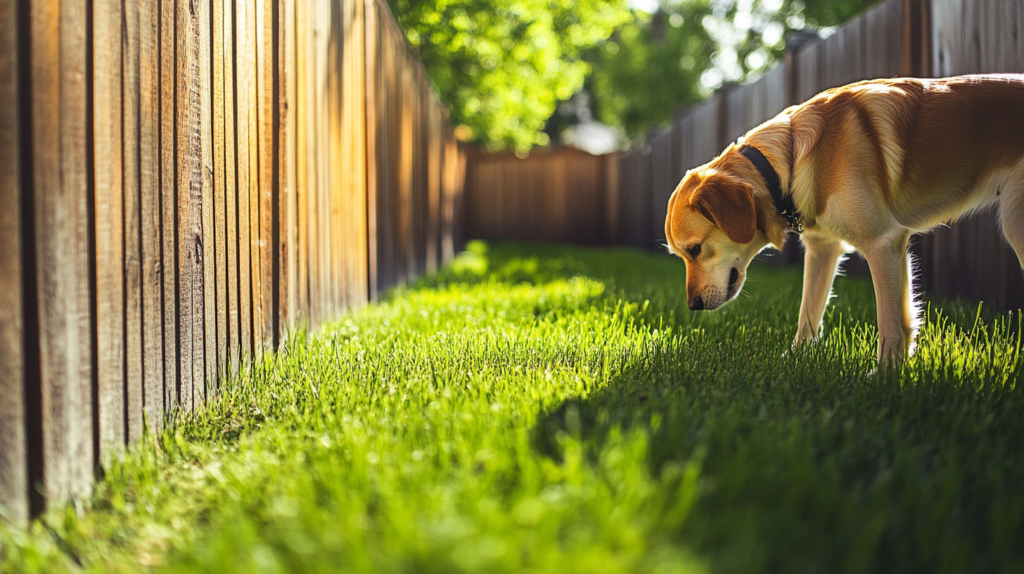
The most fundamental aspect of any safe outdoor space for pets is secure boundaries. Without proper containment, even the most well-trained pets can wander off, encounter dangers, or become lost.
Understanding Your Pet’s Abilities
Before selecting a boundary system, assess your pet’s physical capabilities and tendencies:
- Dogs: Consider breed-specific behaviors—is your dog a digger, jumper, or climber?
- Cats: Are they agile climbers who need overhead protection?
- Small mammals: Do they require completely enclosed spaces when outdoors?
According to a 2023 study in the Journal of Veterinary Behavior, different breeds have distinct escape tendencies. For example, Huskies are notorious for their digging and climbing abilities, while Jack Russell Terriers can squeeze through surprisingly small gaps.
Fencing Options for Maximum Security
The right fencing is your first line of defense in creating a safe outdoor space for pets:
Traditional Fencing
- Height considerations: For dogs, fence height should be at least 6 feet for large or athletic breeds
- Ground security: Extend fencing 12-18 inches underground to prevent digging escapes
- Materials: Choose durable, non-toxic materials like vinyl, wood, or aluminum
- Gap prevention: Ensure gaps between slats are narrow enough to prevent small pets from squeezing through
Cat-Specific Containment
- Cat fencing add-ons: Install inward-facing toppers at 45-degree angles
- Catio options: Consider fully enclosed cat patios that provide fresh air while eliminating escape routes
- Mesh systems: Use fine, strong mesh that cats can’t climb or claw through
Electronic Boundaries
- Invisible fences: Can work for some dogs but offer no protection from outside threats
- Hybrid systems: Combine physical barriers with electronic deterrents for maximum security
- GPS tracking collars: Not a boundary solution alone, but a valuable backup safety measure
A 2024 report by PetSafe Solutions found that homes with properly designed physical barriers experienced 78% fewer pet escape incidents compared to those relying solely on training or electronic containment.
Entry and Exit Points
Don’t overlook these crucial weak spots in your boundary system:
- Install self-closing gates with secure latches
- Consider double-gate systems for high-traffic areas
- Use childproof locks for additional security
- Establish family rules about gate management
- Install gate alarms for added security
Real-Life Success Story: The Thompson family in Colorado installed a specialized digging barrier made of buried hardware cloth along their fence line after their Beagle escaped three times. They haven’t had an escape in over two years, even though their dog still occasionally attempts to dig near the fence.
2. Pet-Friendly Landscaping: Beauty Without Danger
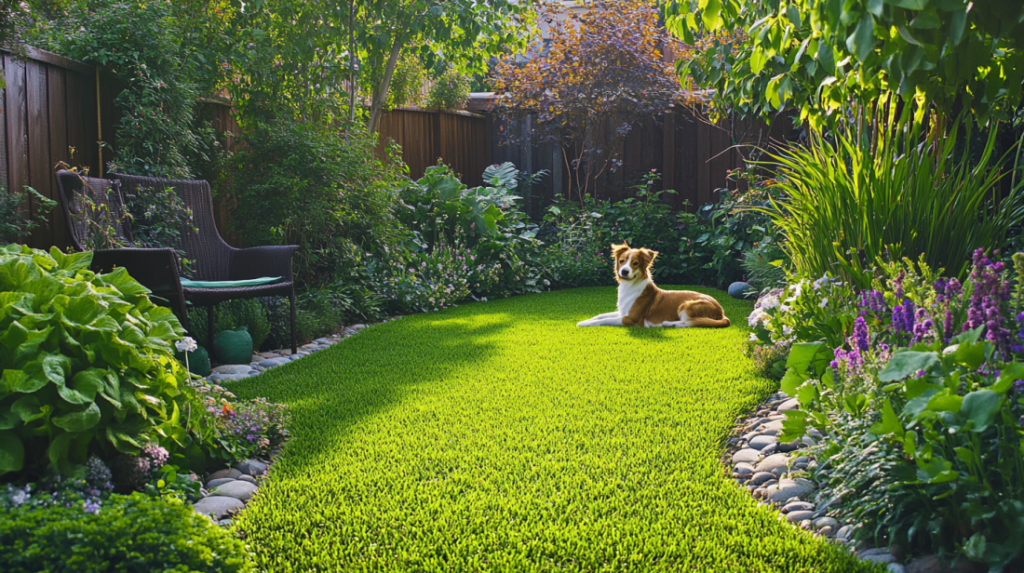
Creating a safe outdoor space for pets requires careful consideration of your landscaping choices. The right approach balances aesthetic appeal with pet safety.
Toxic Plant Elimination
Many common garden plants can be harmful or even fatal to pets if ingested. According to the ASPCA Animal Poison Control Center, plant toxicity prompts thousands of emergency calls annually.
Plants to Remove Immediately:
- Lilies (especially toxic to cats)
- Sago palms
- Azaleas and rhododendrons
- Oleander
- Tulips and daffodils
- Castor bean
- Yew
- Autumn crocus
- Foxglove
Pet-Safe Alternatives
Fortunately, beautiful gardens and pet safety can coexist with these pet-friendly plants:
For Flowering Gardens:
- Roses (remove thorns for added safety)
- Sunflowers
- Petunias
- Snapdragons
- Zinnias
- Marigolds
For Greenery:
- Spider plants
- Boston ferns
- Areca palms
- Bamboo
- Catnip (beneficial enrichment for cats)
- Wheat grass
A 2023 survey by the Garden Council of America found that 62% of pet owners have actively redesigned their gardens to accommodate pet safety needs without sacrificing aesthetic appeal.
Surface Considerations
The ground beneath your pet’s paws matters significantly for their comfort and safety:
- Avoid cocoa mulch: Contains theobromine, toxic to dogs and cats
- Limit rock mulch: Can damage paws and be a choking hazard
- Choose pet-friendly alternatives:
- Cedar mulch (naturally repels fleas and ticks)
- Pine straw (soft on paws)
- Rubber mulch made specifically for pet areas
Hard surfaces:
- Smooth concrete can become dangerously hot in summer months
- Pavers with small gaps can trap small paws
- Consider specialized K9 turf designed for dog play areas
Natural grass considerations:
- Choose tough varieties like Kentucky bluegrass or Bermuda
- Be cautious with lawn treatments—use only pet-safe products
- Create designated paths to prevent worn patches
Water Features: Safety First
Water features add beauty but require careful planning when pets are involved:
- Ensure ponds have gradual edges for easy exit if pets fall in
- Consider a removable pond grid just below the surface
- Choose recirculating fountains over standing water to reduce mosquito risks
- Avoid chemical water treatments harmful to pets
Dr. Jessica Martinez, a veterinary landscaping consultant, recommends: “Create a designated digging area with loose, clean sand in a shaded corner of your yard. Train your dog to use this space by burying toys and treats there. This redirects natural digging behaviors away from your garden beds.”
3. Weather Protection: Comfort in All Conditions
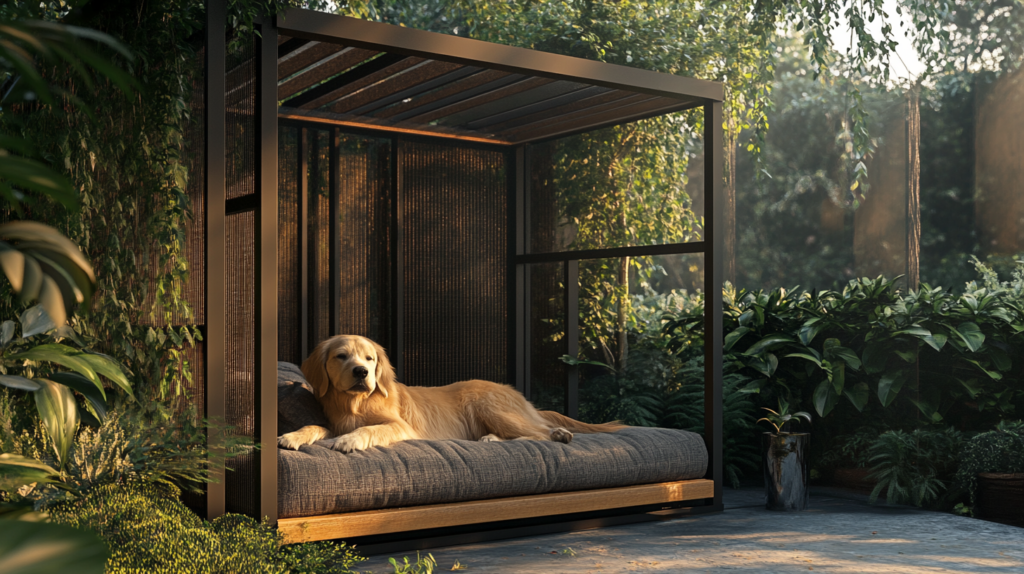
A truly safe outdoor space for pets must offer protection from the elements year-round. Weather extremes can cause serious health issues for pets, from heat stroke to hypothermia.
Shade Solutions
Protection from the sun is essential in any safe outdoor space for pets:
Natural Shade Options:
- Strategically planted trees (ensure they’re pet-safe varieties)
- Pergolas with climbing vines
- Trellises with morning glory or other fast-growing climbers
Artificial Shade Structures:
- Shade sails (secure firmly against wind)
- Gazebos or covered patios
- Pop-up canopies for temporary solutions
- Umbrella stands designed to prevent tipping
According to Dr. Sarah Williams, veterinary meteorologist: “Pets often don’t recognize when they’re overheating. In temperatures above 85°F, always ensure at least 30% of your pet’s outdoor space has reliable shade coverage throughout the day as the sun moves.”
Temperature Management
Beyond shade, consider these temperature control solutions:
Hot Weather Strategies:
- Cooling mats placed in shaded areas
- Misting systems that activate during peak heat
- Shallow wading pools (with supervision)
- Elevated platforms that allow airflow underneath
- Cooling fans in covered areas
Cold Weather Considerations:
- Insulated pet houses positioned away from wind
- Heated outdoor pet mats (with chew-proof cords)
- Windbreaks on the prevailing wind side
- Snow-cleared pathways for bathroom breaks
A 2024 study in Veterinary Environmental Science found that pets with access to varied temperature zones in their outdoor spaces showed significantly lower rates of heat-related illnesses compared to those with limited cooling options.
Rain Protection
Moisture management is often overlooked but important for pet comfort:
- Create covered areas with proper drainage
- Ensure pet houses remain dry inside
- Provide absorbent mats at entry points to your home
- Consider rain shelters at key locations around your yard
Expert Tip: “Position your pet’s outdoor shelter so the opening faces away from prevailing winds and weather patterns. This simple adjustment dramatically improves the shelter’s effectiveness during storms,” advises professional pet space designer Marta Chen.
Seasonal Hazards
Each season brings unique challenges to maintaining a safe outdoor space for pets:
Summer Dangers:
- Asphalt and concrete that can burn paws
- Increased parasite activity
- Toxic seasonal blooms
- Garden chemicals and fertilizers
Winter Concerns:
- Ice-melting chemicals toxic to paw pads
- Frozen water sources
- Hypothermia risks for short-coated breeds
- Snow build-up creating escape routes over fences
Spring/Fall Issues:
- Seasonal allergies affecting pets
- Mud management
- Toxic mushroom growth
- Wildlife activity increases
Dr. Bernard Thompson, emergency veterinarian, notes: “We see a 43% increase in emergency visits during extreme weather events. Most of these could be prevented with proper outdoor space design and weather monitoring.”
4. Enrichment Features: Mental Stimulation Matters
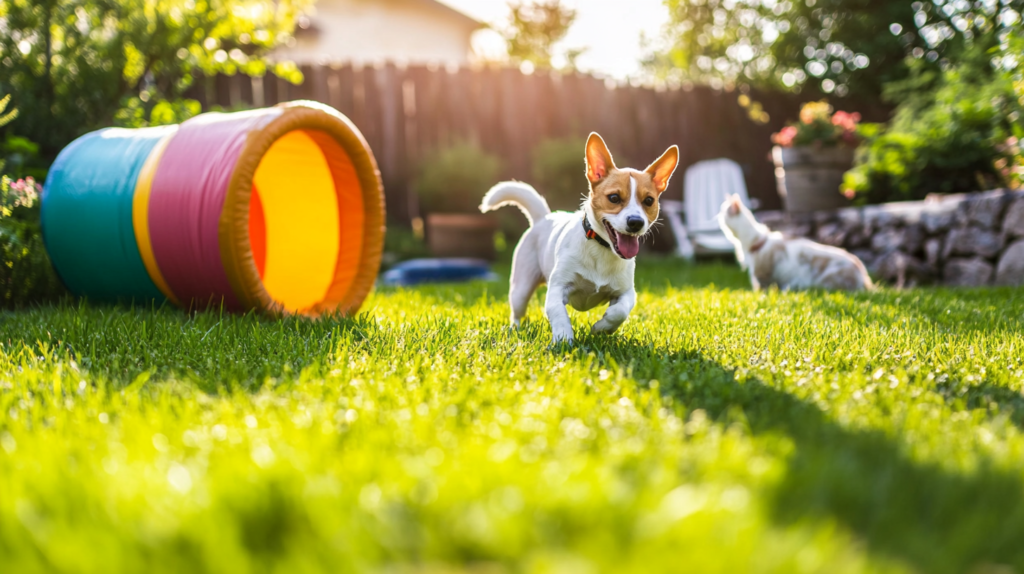
A safe outdoor space for pets should go beyond mere physical safety to address psychological well-being. Environmental enrichment reduces problematic behaviors and improves quality of life.
Species-Specific Play Zones
Different pets have different play needs:
For Dogs:
- Agility equipment scaled to your dog’s size
- Digging pits filled with sand in designated areas
- Varied terrain (hills, steps, flat areas)
- Tunnels and exploration zones
For Cats:
- Vertical climbing spaces (cat trees secured against weather)
- Hidden perches with good visibility of surroundings
- Bird-watching stations with safe distance from actual birds
- Scratching posts designed for outdoor use
For Small Pets:
- Protected grazing areas
- Tunnels and hideaways
- Varied textures for exploration
A 2023 study in Applied Animal Behavior Science found that dogs with access to varied outdoor enrichment showed 64% less destructive behavior inside the home compared to those with plain yard access.
Sensory Gardens
Engage your pet’s senses with specialized garden areas:
Scent Enrichment:
- Herb gardens with pet-safe varieties (rosemary, basil, mint)
- Varying ground covers with different smells
- Scent-releasing items that activate when touched
Tactile Experiences:
- Different ground textures (smooth stones, mulch, grass)
- Shallow water features for pawing
- Brushing stations with different textures
Sound Elements:
- Wind chimes tuned to pet-friendly frequencies
- Bubbling water features
- Bird feeders placed safely beyond reach
Dr. Amanda Rodriguez, animal behaviorist, recommends: “Rotate outdoor toys and enrichment features weekly to maintain novelty. Even moving the same items to different locations can refresh your pet’s interest and encourage exploration.”
Interactive Features
Encourage activity with these engagement options:
- Puzzle feeders designed for outdoor use
- Treat-dispensing toys secured to prevent loss
- Flirt poles installed in secure ground fixtures
- Automated ball launchers for independent play
- Snuffle mats for scent work (bring indoors during wet weather)
Case Study: The Westfield Animal Shelter implemented enrichment stations throughout their outdoor dog areas, rotating features weekly. They reported a pokazal 32% decrease in stress behaviors and improved adoptability of their animals within three months.
Rest Areas
Even active pets need comfortable places to relax:
- Weather-resistant pet beds with washable covers
- Cooling platforms for hot weather
- Hammock-style beds for airflow underneath
- Sheltered napping zones with good visibility
- Thermal bedding for colder seasons
“Create multiple rest areas throughout your outdoor space,” suggests pet environment expert Tomas Lee. “This allows your pet to self-regulate their temperature and comfort by choosing the most appropriate spot as conditions change throughout the day.”
5. Smart Monitoring: Technology for Peace of Mind

Modern technology offers unprecedented ways to enhance your safe outdoor space for pets through monitoring and automation.
Security Cameras
Keep a watchful eye on your pet with these camera solutions:
- Weather-resistant cameras with wide-angle views
- Motion-activated recording features
- Night vision capabilities for 24/7 monitoring
- Two-way audio to communicate with pets remotely
- Cloud storage of footage for reviewing incidents
According to a 2024 PetTech Industry Report, 73% of pet owners who installed outdoor pet cameras reported greater peace of mind when leaving their pets unsupervised in outdoor spaces.
Automated Systems
Technology can actively manage your pet’s outdoor experience:
Water Management:
- Automatic water bowl refilling systems
- Water fountains with filters
- Freeze-resistant water sources for winter
- Water level monitors with smartphone alerts
Environmental Controls:
- Smart misters that activate based on temperature
- Automated shade systems that adjust with sun position
- Weather-responsive pet door locks
- Timed lighting for evening safety
Boundary Reinforcement:
- Smart fence monitors that alert you to potential breaches
- Gate sensors that confirm secure closures
- Pressure sensors that detect digging attempts
- GPS virtual boundaries with smartphone alerts
A comparative analysis by Smart Home Pet Solutions found that homes with automated pet safety systems reported 86% fewer outdoor pet incidents compared to traditional setups.
Health Monitoring
Track your pet’s wellbeing while they enjoy the outdoors:
- Activity trackers designed for outdoor durability
- Temperature sensors for monitoring environments
- Behavioral analysis through AI camera systems
- Water consumption monitors
Real-World Application: The Johnson family installed an integrated smart system for their senior dog with health issues. The system tracks the dog’s location, activity level, and time spent in sun versus shade, sending alerts if patterns suggest potential problems. “It’s transformed how confidently we can let him enjoy the outdoors despite his age,” they report.
Emergency Preparedness
Technology can be crucial during emergencies:
- Weather alert systems that trigger pet recall training
- Automated gates that unlock during fire alarms
- Emergency water releases during extreme heat
- Backup power sources for essential safety features
Dr. Evan Porter, emergency veterinary specialist, emphasizes: “The most effective emergency systems combine technology with good training. A smart alert is useless if your pet hasn’t been conditioned to respond appropriately.”
6. Zoning Your Outdoor Space for Maximum Safety
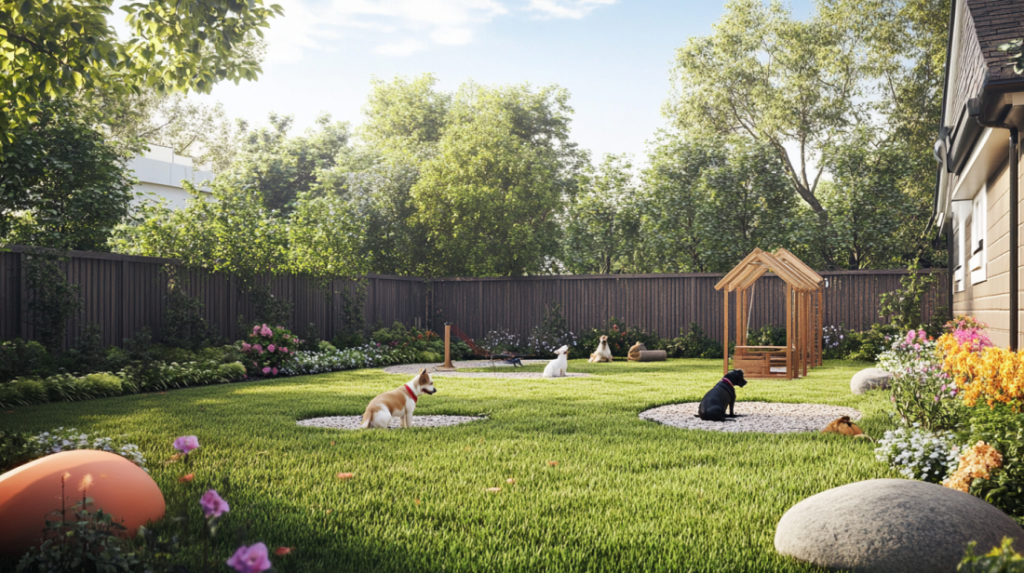
Creating dedicated areas within your outdoor space improves both safety and functionality for your pets.
Bathroom Areas
Designate specific spaces for pet waste:
- Choose locations away from high-traffic areas
- Use specific substrate that signals purpose (pea gravel works well)
- Install proper drainage to prevent contamination
- Consider self-contained dog toilet systems for small spaces
- Use visual boundaries like decorative edging
Maintaining these areas is essential:
- Implement daily cleaning routines
- Use pet-safe disinfectants monthly
- Replace substrate seasonally as needed
- Install motion-activated lighting for nighttime use
“A well-designed bathroom area reduces parasitic transmission and keeps the rest of your yard more enjoyable,” notes veterinary parasitologist Dr. Hannah Kim.
Eating and Drinking Stations
Create dedicated dining areas with these considerations:
- Position in partially shaded locations
- Install sturdy, non-tip food and water stations
- Elevate feeding stations to reduce ant problems
- Consider automated feeders for scheduled meals
- Install easy-clean surfaces underneath
According to pet nutritionist Dr. Carlos Mendez: “Outdoor feeding stations should be positioned away from garden areas to prevent association between plants and food, which can encourage unwanted plant sampling.”
Exercise vs. Relaxation Zones
Clearly separate active and quiet areas:
Active Zones Should Include:
- Impact-absorbing surfaces for joint health
- Open running paths with good visibility
- Play equipment appropriate for your pet’s size and age
- Easily sanitized surfaces for multiple pets
Relaxation Zones Need:
- Buffer areas between active zones
- Sound dampening features like dense shrubbery
- Limited access points to control flow
- Natural stress-reducing elements like gentle water sounds
A 2023 study in Companion Animal Psychology found that pets with clearly defined activity zones showed better behavioral regulation and reduced anxiety compared to those in undifferentiated spaces.
Wildlife Management Areas
Create safe interactions with local fauna:
- Bird-watching stations positioned safely behind windows
- Elevated platforms for observing neighborhood activities
- Wildlife-proof compost and trash containment
- Natural deterrents for unwanted animal visitors
Pet behavior specialist Jamie Williams recommends: “Position wildlife-watching zones where your pet can observe without direct access. This provides mental stimulation without the risks of actual wildlife encounters.”
7. Seasonal Maintenance for Ongoing Safety
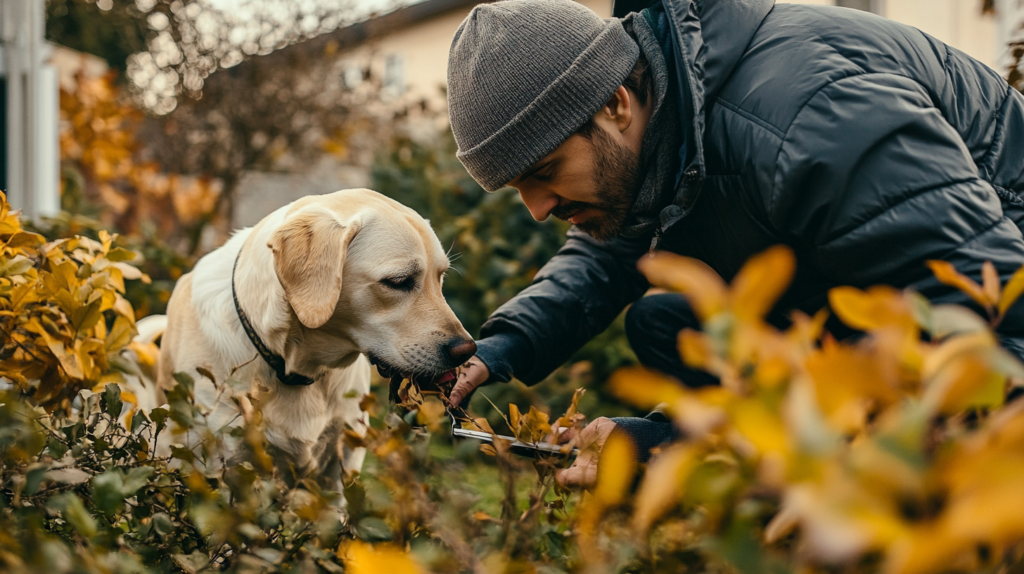
A safe outdoor space for pets requires regular upkeep as seasons change.
Spring Readiness
Prepare for increased outdoor time with these steps:
- Inspect and repair winter fence damage
- Check for exposed nails or sharp edges on structures
- Test all gates and latches for winter damage
- Remove any toxic spring bulbs or plants
- Inspect trees for dangerous hanging branches
- Update parasite prevention for increased outdoor exposure
“Spring is when we see the most escape-related emergencies,” warns Dr. Lisa Chen, emergency veterinarian. “Winter damage to fences may not be obvious until your pet finds the weak spot.”
Summer Safety Checks
Heat brings specific maintenance needs:
- Test irrigation to ensure mud-free zones
- Clean and refill water features to prevent algae
- Trim overgrown plants that may harbor ticks
- Check shade structures for sun rot or weather damage
- Test soil temperatures in direct sun areas
- Ensure ventilation in enclosed pet spaces
According to a 2024 survey by PetSafe Outdoors, 58% of reported heat-related pet emergencies occurred in yards that hadn’t been “summer-proofed” with adequate shade and water access.
Fall Preparations
Autumn requires these specific maintenance tasks:
- Remove toxic mushrooms that emerge in damp conditions
- Secure compost piles against pet access
- Clear leaf accumulation from water features
- Check outdoor pet houses for weather-tightness
- Secure holiday decorations against curious pets
- Test outdoor lighting as daylight hours decrease
Professional pet landscaper Devon Rodriguez suggests: “Fall is the ideal time to add weather protection features before winter arrives. Consider adding windbreaks and insulation to outdoor pet structures while temperatures are still moderate.”
Winter Weatherproofing
Cold weather demands these protective measures:
- Insulate outdoor water pipes for continuous access
- Apply pet-safe ice melting products on walkways
- Check snow accumulation against fences for potential escape routes
- Provide wind barriers around primary outdoor areas
- Install weather stripping on outdoor pet structures
- Consider heated outdoor mats for comfort
A 2023 winter pet safety report found that properly winterized outdoor pet spaces reduced cold-weather incidents by 74% compared to unprepared spaces.
Professional Assessment Option: Consider hiring a pet safety consultant for an annual inspection of your outdoor space. These professionals can identify potential hazards that might be overlooked and recommend seasonal updates specific to your region and pet species.
Ready to Create Your Pet’s Safe Outdoor Paradise?
Creating a safe outdoor space for pets requires thoughtful planning, appropriate materials, and ongoing maintenance. By implementing the strategies outlined in this guide, you’ll be well on your way to providing an enriching environment that meets your pet’s physical and psychological needs while keeping them protected from harm.
Remember that each pet is unique, with individual preferences and requirements. Observe how your pet interacts with their outdoor space and be prepared to make adjustments based on their behavior and needs.
For more expert pet care tips and product recommendations, visit BlithePet.com – your trusted source for pet wellness.
FAQ: Safe Outdoor Spaces for Pets
Q: How much space do I need to create a safe outdoor area for my pet?
A: While more space offers more options, even small areas can become enriching pet havens. Balconies, patios, and small yards can all be transformed with vertical features, appropriate containment, and rotating enrichment options. The quality of the space matters more than quantity.
Q: Are invisible fences a good option for creating boundaries in my pet’s outdoor space?
A: Invisible fences can be supplemental tools for some dogs but have significant limitations. They don’t prevent other animals from entering your yard, can malfunction during power outages, and may not stop a highly motivated pet from crossing boundaries. Physical barriers remain the gold standard for creating a safe outdoor space for pets.
Q: What’s the best way to pet-proof my garden without removing all my existing plants?
A: Start by identifying and removing the most toxic plants immediately. For moderately toxic varieties, consider transplanting them to inaccessible areas or using decorative fencing to block pet access. Additionally, training your pet to avoid certain areas through positive reinforcement can be effective when combined with physical barriers.
Q: How do I create a safe outdoor space for both cats and dogs who share the same yard?
A: Multi-pet households benefit from zone creation. Provide escape routes and elevated spaces where cats can retreat from dogs when desired. Ensure any cat containment systems won’t trap them if they’re being chased. Schedule separate outdoor time if your pets don’t interact well, and always supervise initial shared outdoor experiences.
Q: What are the most cost-effective improvements I can make to my pet’s outdoor space?
A: Focus first on secure boundaries and shade provision, as these address the most immediate safety concerns. DIY projects like homemade digging pits, upcycled pallet pet furniture, and repurposed containers for plant barriers offer affordable enhancements. Natural enrichment through varied terrain and scent experiences costs little but provides significant benefits.
Q: How can I create a safe outdoor space for my pet in an apartment setting?
A: Balconies and small patios can become “mini catios” or “doggy porches” with appropriate modifications. Install secure mesh or plexiglass panels on railings, use lightweight, weatherproof containers for pet-safe plants, and create multiple levels with shelving. Weather protection becomes especially important in these smaller spaces, so include both sun and rain shields.
Conclusion: A Lifetime of Outdoor Enjoyment
Creating a safe outdoor space for pets is an ongoing journey rather than a one-time project. As your pet ages, their needs may change. Puppies require different safety considerations than senior dogs, just as kittens interact with their environment differently than older cats.
By implementing the strategies outlined in this comprehensive guide—from secure boundaries and pet-friendly landscaping to weather protection, enrichment features, and smart monitoring—you’ll create an outdoor haven where your pet can thrive. Regular maintenance and seasonal updates ensure this space remains safe year after year.
The investment you make in creating a safe outdoor space for your pet will pay dividends in their physical health, mental wellbeing, and overall quality of life. When pets have appropriate spaces to express natural behaviors, they develop fewer problematic behaviors indoors and often enjoy stronger bonds with their human companions.
Have a similar experience with your pet? Share it in the comments below!

